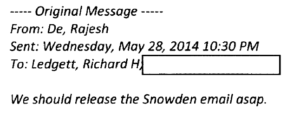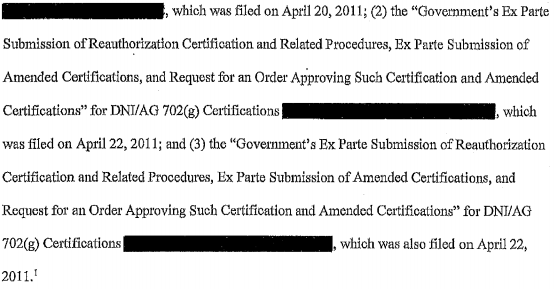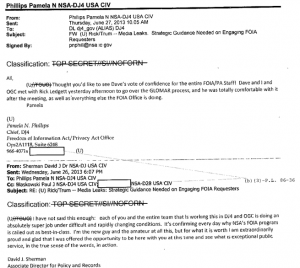Why I Left The Intercept: The Surveillance Story They Let Go Untold for 15 Months
The Intercept has a long, must-read story from James Risen about the government’s targeting of him for his reporting on the war on terror. It’s self-serving in many ways — there are parts of his telling of the Wen Ho Lee, the Valerie Plame, and the Jeffrey Sterling stories he leaves out, which I may return to. But it provides a critical narrative of DOJ’s pursuit of him. He describes how DOJ tracked even his financial transactions with his kids (which I wrote about here).
The government eventually disclosed that they had not subpoenaed my phone records, but had subpoenaed the records of people with whom I was in contact. The government obtained my credit reports, along with my credit card and bank records, and hotel and flight records from my travel. They also monitored my financial transactions with my children, including cash I wired to one of my sons while he was studying in Europe.
He also reveals that DOJ sent him a letter suggesting he might be a subject of the investigation into Stellar Wind.
But in August 2007, I found out that the government hadn’t forgotten about me. Penny called to tell me that a FedEx envelope had arrived from the Justice Department. It was a letter saying the DOJ was conducting a criminal investigation into “the unauthorized disclosure of classified information” in “State of War.” The letter was apparently sent to satisfy the requirements of the Justice Department’s internal guidelines that lay out how prosecutors should proceed before issuing subpoenas to journalists to testify in criminal cases.
[snip]
When my lawyers called the Justice Department about the letter I had received, prosecutors refused to assure them that I was not a “subject” of their investigation. That was bad news. If I were considered a “subject,” rather than simply a witness, it meant the government hadn’t ruled out prosecuting me for publishing classified information or other alleged offenses.
But a key part of the story lays out the NYT’s refusals to report Risen’s Merlin story and its reluctance — until Risen threatened to scoop him with his book — to publish the Stellar Wind one.
Glenn Greenwald is rightly touting the piece, suggesting that the NYT was corrupt for acceding to the government’s wishes to hold the Stellar Wind story. But in doing so he suggests The Intercept would never do the same.
That’s not correct.
One of two reasons I left The Intercept is because John Cook did not want to publish a story I had written — it was drafted in the content management system — about how the government uses Section 702 to track cyberattacks. Given that The Intercept thinks such stories are newsworthy, I’m breaking my silence now to explain why I left The Intercept.
I was recruited to work with First Look before it was publicly announced. The initial discussions pertained to a full time job, with a generous salary. But along the way — after Glenn and Jeremy Scahill had already gotten a number of other people hired and as Pierre Omidyar started hearing from friends that the effort was out of control — the outlet decided that they were going to go in a different direction. They’d have journalists — Glenn and Jeremy counted as that. And they’d have bloggers, who would get paid less.
At that point, the discussion of hiring me turned into a discussion of a temporary part time hire. I should have balked at that point. What distinguishes my reporting from other journalists — that I’m document rather than source-focused (though by no means exclusively), to say nothing of the fact that I was the only journalist who had read both the released Snowden documents and the official government releases — should have been an asset to The Intercept. But I wanted to work on the Snowden documents, and so I agreed to those terms.
There were a lot of other reasons why, at that chaotic time, working at The Intercept was a pain in the ass. But nevertheless I set out to write stories I knew the Snowden documents would support. The most important one, I believed, was to document how the government was using upstream Section 702 for cybersecurity — something it had admitted in its very first releases, but something that it tried to hide as time went on. With Ryan Gallagher’s help, I soon had the proof of that.
The initial hook I wanted to use for the story was how, in testimony to PCLOB, government officials misleadingly suggested it only used upstream to collect on things like email addresses.
Bob Litt:
We then target selectors such as telephone numbers or email addresses that will produce foreign intelligence falling within the scope of the certifications.
[snip]
It is targeted collection based on selectors such as telephone numbers or email addresses where there’s reason to believe that the selector is relevant to a foreign intelligence purpose.
[snip]
It is also however selector-based, i.e. based on particular phone numbers or emails, things like phone numbers or emails.
Raj De:
Selectors are things like phone numbers and email addresses.
[snip]
A term like selector is just an operational term to refer to something like an email or phone number, directive being the legal process by which that’s effectuated, and tasking being the sort of internal government term for how you start the collection on a particular selector.
[snip]
So all collection under 702 is based on specific selectors, things like phone numbers or email addresses.
Brad Wiegmann:
A selector would typically be an email account or a phone number that you are targeting.
[snip]
So that’s when we say selector it’s really an arcane term that people wouldn’t understand, but it’s really phone numbers, email addresses, things like that.
[snip]
So putting those cases aside, in cases where we just kind of get it wrong, we think the email account or the phone is located overseas but it turns out that that’s wrong, or it turns out that we think it’s a non-U.S. person but it is a U.S. person, we do review every single one to see if that’s the case.
That PCLOB’s witnesses so carefully obscured the fact that 702 is used to collect cybersecurity and other IP-based or other code collection is important for several reasons. First, because collection on a chat room or an encryption key, rather than an email thread, has very different First Amendment implications than collecting on the email of a target. But particularly within the cybersecurity function, identifying foreignness is going to be far more difficult to do because cyberattacks virtually by definition obscure their location, and you risk collecting on victims (whether they are hijacked websites or emails, or actual theft victims) as well as the perpetrator.
Moreover, the distinction was particularly critical because most of the privacy community did not know — many still don’t — how NSA interpreted the word “facility,” and therefore was missing this entire privacy-impacting aspect of the program (though Jameel Jaffer did raise the collection on IP addresses in the hearing).
I had, before writing up the piece, done the same kind of iterative work (one, two, three) I always do; the last of these would have been a worthy story for The Intercept, and did get covered elsewhere. That meant I had put in close to 25 hours working on the hearing before I did other work tied to the story at The Intercept.
I wrote up the story and started talking to John Cook, who had only recently been brought in, about publishing it. He told me that the use of 702 with cyber sounded like a good application (it is!), so why would we want to expose it. I laid out why it would be questionably legal under the 2011 John Bates opinion, but in any case would have very different privacy implications than the terrorism function that the government liked to harp on.
In the end, Cook softened his stance against spiking the story. He told me to keep reporting on it. But in the same conversation, I told him I was no longer willing to work in a part time capacity for the outlet, because it meant The Intercept benefitted from the iterative work that was as much a part of my method as meetings with sources that reveal no big scoop. I told him I was no longer willing to work for The Intercept for free.
Cook’s response to that was to exclude me from the first meeting at which all Intercept reporters would be meeting. The two things together — the refusal to pay me for work and expertise that would be critical to Intercept stories, as well as the reluctance to report what was an important surveillance story, not to mention Cook’s apparent opinion I was not a worthy journalist — are why I left.
And so, in addition to losing the person who could report on both the substance and the policy of the spying that was so central to the Snowden archives, the story didn’t get told until 15 months later, by two journalists with whom I had previously discussed 702’s cybersecurity function specifically with regards to the Snowden archive. In the interim period, the government got approval for the Tor exception (which I remain the only reporter to have covered), an application that might have been scrutinized more closely had the privacy community been discussing the privacy implications of collecting location-obscured data in the interim.
As recently as November, The Intercept asked me questions about how 702 is actually implemented because I am, after all, the expert.
So by all means, read The Intercept’s story about how the NYT refused to report on certain stories. But know that The Intercept has not always been above such things itself. In 2014 it was reluctant to publish a story the NYT thought was newsworthy by the time they got around to publishing it 15 months later.





